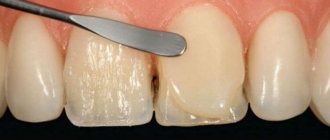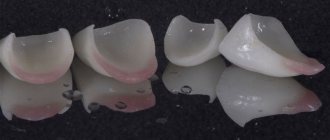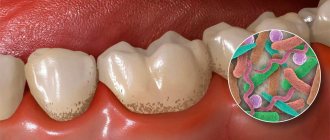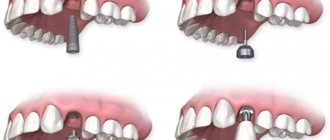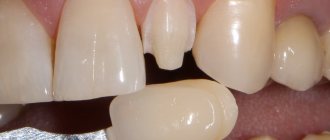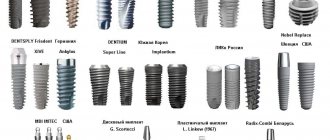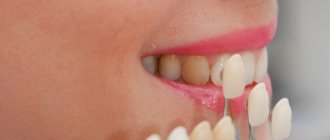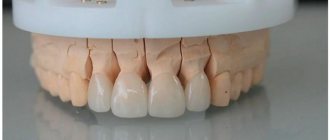A beautiful smile is a person’s calling card. The condition of your teeth affects not only your physical but also your mental health. It is also an indicator of success.
Previously, dentistry used dental crowns to restore even slightly damaged teeth. To do this, they had to sacrifice their natural teeth and subject them to severe grinding. Or remove the coronal part completely.
Now technologies make it possible to eliminate defects on the surface of the tooth, practically without processing it. For this, ultra-thin plates are used that are fixed on the outside of the tooth - veneers. The most popular of them are ceramic veneers, which have a high degree of aesthetics.
What it is?
Despite their ultra-thinness, the strength of the plates is comparable to the hardness of natural tooth enamel. The material allows you to repeat the shape of the tooth with maximum accuracy, hiding visible defects on its surface.
The demand for ceramic veneers is due to their practicality and full compatibility with the human body. The pads are non-toxic, do not cause allergic reactions, and do not require addiction. The translucent material is identical to natural tooth enamel. The shade scale allows you to select the color of the veneers that is similar to the shade of the patient’s teeth.
There are no problems with installing veneers: the plates are attached to the outside of the tooth using a dental compound.
When can veneers be installed and what are the contraindications?
Indications for use:
- minor chips on tooth enamel;
- outdated fillings, which due to their long service life have changed their color and are very different from the tooth;
- the tooth surface is worn out;
- the presence of diseases that led to the appearance of stains on tooth enamel (for example, necrosis, erosion, fluorosis, hypoplasia, etc.);
- tooth enamel has darkened due to the use of resorcinol-formalin paste, which is used to fill canals;
- the presence of large or small gaps between teeth.
Contraindications for installing veneers may include:
- night grinding of teeth (bruxism);
- insufficient volume of tooth enamel (plates are attached to its surface, and insufficient volume can serve as a contraindication);
- the tooth has not completely erupted;
- the presence of serious pathologies in the bite;
- the thinness of the enamel, which provokes frequent chipping in large areas;
- caries with subsequent complications;
- the presence of diseases such as gingivitis, periodontitis or periodontal disease (you will first need to undergo treatment).
Also, the doctor may refuse to install plates if the teeth have large fillings or the tooth is particularly fragile. These contraindications do not guarantee the long service life of the veneer; even the strongest crown may fall off in a couple of months.
pros
Fixing veneers is the fastest and most painless way to restore the aesthetics of teeth. Yes, the teeth are pre-treated. However, turning is no more than 0.5 mm.
The minimum duration of the procedure is associated not only with the immediate installation of veneers, but also with the number of visits to the dentist. If the patient does not require pre-treatment, the entire process will require no more than 3 visits to the doctor.
Important: you should not trust advertising that promises a Hollywood smile using veneers in one session. The plates are made in a dental laboratory based on previously taken impressions of the patient’s jaw. The work is complex, requiring extreme concentration and high professionalism. Therefore, it is impossible to create ceramic veneers in an hour or even in 2 hours.
Some methods of prosthetics require a long period of getting used to new teeth. Overlays do not fall into this category. After fixing microprostheses, unusual sensations may occur due to the appearance of a foreign structure in the oral cavity. But in just a day or two, the discomfort will disappear. Ceramic veneers do not affect the patient’s usual lifestyle, eating and diction.
Long service life is one of the main advantages of the plates. On average, veneers “live” for at least 15-20 years. When used correctly, of course. In addition, microprostheses can be installed in patients with high sensitivity - rejection and allergic reactions are excluded.
How long do veneers last?
Based on the material from which they are made, linings are divided into ceramic
and
composite
. The first ones are made from impressions in a dental laboratory, and the second ones are made directly in the dentist’s chair. The quality of the material is completely different and the fracture toughness of different types of linings differs significantly. But it is this that determines the service life.
Disadvantages of the design
The main disadvantage of veneers is the price. For this reason, the procedure is not available to everyone. If we are talking about a minor flaw, then you can choose a more budget option - composite veneers. The material is applied directly to the tooth surface. And under the influence of the light flux, it gradually, layer by layer, hardens, forming a plate.
If the problem is related to darkening of the enamel, you can use a professional whitening procedure. The service is less expensive, but no less effective.
Another disadvantage of plates is the grinding of teeth. No matter what thin ceramic veneers are used, it will not be possible to simply remove the structure from the teeth. You will need to install a new onlay or crown.
What are veneers and when should they be installed?
Veneers are thin plates of ceramic or other material that are placed on the surface of the tooth and secured with dental cement. They are designed to hide some of the defects, such as: a yellow tint of the enamel that cannot be whitened, fluorosis, small cracks, chips, cracks and diastemas.
The use of veneers in dentistry belongs to the section of microprosthetics. Onlays do not perform the function of a tooth, but give the patient a spectacular appearance of the frontal area.
In aesthetic dentistry, different onlays are used. Veneers, lumineers and ultraneers can restore the beauty of teeth. The thickness of the veneer plates is 0.5-1.5 mm, lumineers - 0.2 mm, ultraneers - 0.3-0.5 mm. They serve not just one year, but 10-20 years, depending on the chosen material.
In what cases are plates installed?
The main purpose of onlays is to eliminate aesthetic defects on the front teeth. It can be:
- Chips and cracks.
- Previously installed fillings that have changed color or cracked.
- Interdental gaps and tooth pigmentation that cannot be eliminated by professional cleaning.
- Pathological abrasion of enamel.
In addition, ceramic veneers help correct minor changes in the bite, crooked teeth, and a decrease in the volume of gum tissue.
Types of veneers
In dentistry, several types of veneers are used, selected by specialists depending on the task ahead - to add volume to the crown, lighten it or remove the diastema (interdental gap). Materials for making durable and beautiful products:
- Acrylic – often used to cover a tooth for a short period of time to create permanent veneers. It is heavy, which makes the wearing process less comfortable and aesthetically pleasing, since the thickness of the crown increases to 0.7-0.9 mm and looks unnatural. A temporary solution is used while the patient is waiting for veneers made from a different material.
- Porcelain - the production of overlays with a thickness of 0.3-0.1 mm takes a lot of time and expensive medical substances with the addition of special dyes that ensure aesthetics and maximum naturalness of the product. Advantages of porcelain plates:
- Refractory porcelain is the most popular because it is virtually indistinguishable in color from natural teeth.
- The minimum thickness makes them completely invisible.
- The material is absolutely hypoallergenic and does not cause negative reactions in the patient’s body.
- Porcelain veneers are used only on the front teeth to prevent heavy chewing stress.
- Their advantage is manifested in their resistance to the formation of tartar and staining with food dyes.
- Teeth retain their natural shine and size.
- Composite veneers are made from several components. The composition must contain a material that holds all the ingredients together, giving composite veneers (0.6-0.7 mm thick) strength against moderate mechanical damage. Their color is completely uniform, which sometimes looks unnatural. With frequent consumption of coffee, strong tea and food with natural dyes, composite linings may turn yellow. When are composite veneers used:
- To eliminate the central diastema.
- Hiding white and yellowish spots due to fluorosis, severe darkening of the enamel.
- Making the shape of the dentition more aesthetically pleasing.
- Restoration of a damaged tooth.
- It is worth noting that the composite substance does not interfere with x-rays of the jaws without distorting the image of the tooth.
- Ceramic veneers provide complete optical naturalness to tooth crowns. Their price is significantly higher than composite products due to their better appearance and greater strength. They are translucent and, after gluing to the tooth enamel, create a single structure with it. Thanks to this, the unnatural effect will not be noticeable in the photographs.
- Zirconium onlays can be used to make veneers for a large number of teeth at once. Porcelain base, made of zirconium or aluminum oxide, is a very durable material that can naturally reflect light, much like real human teeth. The thickness of a zirconium veneer is about 0.6-0.7 mm. The very durable material is completely biocompatible. There is a subtype of ceramic veneers - lumineers, the “Hollywood” version is characterized by a more matte and brighter white hue.
Contraindications
Despite the versatility and practicality of the technique, there are limitations to the installation of veneers. For example, the use of plates is contraindicated in cases of bruxism, the presence of inflammatory processes, bone tissue pathology, and malocclusion.
Also, ceramic veneers are not used for the restoration of severely damaged teeth (more than 50%). In this case, the doctor installs crowns.
A refusal to carry out the procedure may be the presence of bad habits (biting nuts, nails, opening bottles with teeth, etc.). Or a high risk of maxillofacial injury. For example, extreme sports.
Gum disease and loss of chewing teeth will also require preliminary treatment before installing plates.
Production technology
Ceramic veneers are usually made using three techniques:
- Applying the composition to a plaster model followed by heat treatment. The dental technician evenly distributes the composition over the surface of a special material that holds the paste during firing. The technique is inexpensive and allows reducing shrinkage of the structure.
- Casting. In this case, a model of future ceramic veneers is first created using wax. Then it is fixed in a refractory mass and installed in the sprue. Processing is carried out under high temperature. At the final stage, the dental technician paints the plates in a color that matches the patient’s tooth enamel.
- Pressing (Emax). More modern technology that reduces the porosity of the material. This ensures maximum structural strength. As a result, pressed plates have a longer service life. After processing, ceramic veneers are coated with a special compound that adds shine to the overlays.
Recently, the digital method of making veneers using a milling cutter has become popular. The model for the plates is obtained using a non-contact scan of the patient's oral cavity. A computer program calculates the structure. The sample is then sent for milling. The advantages of the method are obvious: the automated process eliminates possible inaccuracies and errors in the production of microprostheses.
Manufacturing and installation
The entire process of prosthetic veneers takes about a week and involves two visits to the dentist.
How are veneers made?
Porcelain veneers can be made in two ways:
- layer-by-layer application and firing of porcelain mass (when working with unpressed ceramics);
- injection molding under the influence of high temperatures and pressure (this is how linings are made from pressed ceramics, which are considered more durable than those made from unpressed ceramics).
Microprostheses made of zirconium dioxide are manufactured using CAD/CAM technology:
- The CAD system creates a three-dimensional model of the overlay using a computer;
- The CAM system allows you to produce microprostheses according to a three-dimensional model on a highly accurate automatic milling machine (without human intervention).
The fastest way to automatically create a veneer from zirconium dioxide is to use the Cerec device (a set of technologies, equipment and materials for the production of ceramic microprostheses).
How are porcelain veneers installed?
Installation includes the following steps:
- Choice of color and type of overlay.
- Odontopreparation (removal of hard tooth tissues). To install conventional veneers and ultra-veneers, it is necessary to grind away from the tooth surface from half to one and a half millimeters. Lumineers are installed without grinding.
- Making an impression of the prepared tooth.
- Fixing a temporary plastic onlay (the ground tooth needs protection from the aggressive environment of the oral cavity while the onlay is being manufactured).
- Laboratory production of veneers based on impressions taken.
- Fastening the microprosthesis.
When installing lumineers, the second and fourth stages are omitted.
Diagnostics
The fixation of ceramic plates is carried out in three stages: preparation for the installation of veneers, production of the structure and fixation on the teeth.
Correctly performed diagnostics determines how long the orthopedic structure will serve the patient. In addition to the condition of the teeth, it is important to identify possible hidden pathologies in the bone and soft tissues of the jaw. And also carefully study the anatomical structure of the teeth being restored.
At EspaDent clinics, specialists conduct radiographic examinations for more accurate diagnosis. In complex cases, a modern 3D tomograph is used, which creates three-dimensional, layer-by-layer images of both jaws. During a consultation in our clinics, the doctor will offer the best options for microprostheses and immediately indicate the cost of the procedure.
How does the installation work?
If the patient does not require preliminary treatment, the next step is professional oral hygiene. The dentist removes hard and soft plaque from the teeth and disinfects the oral cavity. Before treating the teeth, the specialist selects the color of future ceramic veneers according to the Vita shade scale. Grinding of teeth is carried out in a gentle manner, without pain. If necessary, safe local anesthesia is used.
Next, the doctor proceeds to taking impressions of the teeth. According to the chosen method, first a model of the plates is made, and then the final microprosthesis. On average, the production of ceramic veneers takes 1-2 weeks, depending on the complexity of the design.
While the patient waits for new veneers, temporary plastic or composite veneers are fixed to the treated teeth. Onlays protect your natural teeth from bacteria. They also provide chewing function before the installation of microprostheses.
After the plates are ready, the doctor fixes them on the teeth one by one. Each dental unit requires approximately 30-60 minutes.
How much does it cost to install a veneer on 1 tooth?
The price of a veneer per tooth depends on the material and the chosen clinic. The most inexpensive microprostheses are made of composite, but they are also short-lived. Ceramic and zirconium veneers are about the same price. Some professional clinics offer a “turnkey veneers” service, this will help avoid additional costs and risks. For your information, we offer a table with Moscow dentists where veneers can be installed.
| Dentistry | Website | Address | Composite veneer price | Price of ceramic veneer |
| ROOT Center | https://dentalroott.ru |
| from 15,000 rub. | from 37,000 rub. (all inclusive) |
| Implant Ru | https://www.implant.ru |
| — | from 36,000 rub. |
| City-Dent | https://city-dent.rf |
| from 7,000 rub. | from 15,000 rub. |
| The president | https://www.prezi-dent.ru |
| from 11,500 rub. | from 20,000 rub. |
| Center Family Dentistry | https://family-dental.ru |
| — | from 31,000 rub. |
Classification of structures
Microprostheses are distinguished by the type of material used in their manufacture. Ceramic veneers, without impurities, are considered traditional. For example, porcelain or pressed ceramics. The advantage of these plates is their impeccable aesthetics. The veneers look natural and neat on the teeth. But ceramics are far from the most durable material. It is not able to withstand significant chewing load.
To increase strength, dentistry has developed zirconium dioxide veneers. In this case, the microprosthesis consists of two layers: a zirconium base and a ceramic lining. Dental crowns are made using the same principle. Important: these plates are metal-free. It is not zirconium (metal) that is used here, but zircon, a natural white mineral. The stone has increased hardness, which allows it to be used to restore lateral teeth. However, the aesthetics of zirconium plates are far from perfect, so after production, an additional layer of ceramic is applied to the veneers. The result is durable ceramic veneers with enamel identical to natural teeth.
The third group includes lumineers - ultra-thin plates. The thickness of the onlays does not exceed 0.2-0.3 mm, which minimizes the process of grinding the teeth. The use of lumineers allows you to hide flaws in the dentition, while preserving the enamel of your natural teeth. The minimum thickness does not affect the functionality of microprostheses in any way. The plates can withstand full chewing load, without chips or cracks. However, there is also a downside: the manufacture and installation of ultra-thin veneers is similar in complexity to jewelry work. High qualifications of both the dental technician and the dentist are required. Which leads to an increase in the cost of the procedure. The cost of making lumineers can be 3-4 times higher than traditional porcelain veneers.
"Hollywood" porcelain veneers
Special mention should be made of the so-called “Hollywood” veneers or lumineers (from the English luminary - luminary). These microprostheses have been decorating the smiles of American celebrities for 20 years now. Lumineers were once preferred by George Clooney, Tom Cruise, Angelina Jolie, Gwyneth Paltrow and other stars.
Lumineers are made from the strongest ceramics and are only 0.2-0.3 mm thick. The method of their production is patented and kept secret. These are the only microprosthetic onlays that are fixed to unground teeth.
Budget analogue
There is an easier and faster way to restore teeth. Composite veneers help with this - a polymer in the form of a paste that is applied directly to the surface of the tooth. The composition is mixed in the dentist's office, which allows you to complete the procedure in one visit. Of course, if there is no need for preliminary treatment of teeth and soft tissues.
The composite has good aesthetics and does not require significant grinding of natural teeth. Hardening is carried out layer by layer, under the influence of light flux. This provides the necessary strength to microprostheses. The technique is suitable for restoring lateral teeth.
Disadvantages of polymer restoration:
- Shorter service life compared to ceramic veneers - no more than 5-6 years.
- Instability to pigmentation. The material changes color over time and absorbs coloring components.
- Imperfect match to the shade of natural enamel.
Types of veneers and the effect of material on service life
The term “veneers” is very broad and includes products that differ not only in the characteristics of the material, but also in the concept of processing and installation. All veneers can be divided into two large categories.
- Direct veneers. They are not made in a laboratory, but are modeled directly in the patient's mouth. The material for such veneers is a composite that hardens under the influence of ultraviolet radiation.
- Indirect veneers. The products are similar to thin plates produced in a dental laboratory. To make them, you need to take casts or models on a computer. These are veneers in the classical sense, which are also called orthopedic and laboratory. They can be made from different types of ceramics. The duration also depends on the characteristics of the material.
In general, direct and indirect veneers are different products. Composite veneers do not require a laboratory stage and belong to the field of artistic restoration. They are usually installed by a board-certified dentist who allows esthetic restorations to be performed using composite materials. Indirect veneers are already microprostheses, so they are installed by an orthopedic dentist. On the other hand, both types of veneers serve the same aesthetic purposes. With their help, you can hide chips, cracks, slight bends of teeth, imperfections in the color and structure of tooth enamel.
Manufacturers
To protect yourself from low-quality prosthetics, check with the clinic about what materials are used in the procedure. Mainly large companies specialize in the production of ceramic veneers. There aren't many of them.
The most famous company Nobel Biocare is a leader in implantology and prosthetics. It was this manufacturer that developed the popular protocols for implantation procedures All-on-4, All-on-6, Trefoil, etc. In the case of installing veneers, the company specializes in the production of zirconium plates.
The list includes German and Japanese companies that produce their products under the brands Katana, Prettau and BruxZir Anterior. The leader in the production of pressed and solid ceramics is Ivoclar Vivadent, which specializes in Emax technology.
Many years of experience, modern materials and strict quality control allow these companies to occupy a strong position in the dental materials market.
The difference between composite veneers and ceramic
There is no point in trying to choose the perfect option. Each technique has its own advantages and disadvantages. For example, porcelain plates are most effective for restoring the front row of teeth, in the smile area.
On the contrary, the use of composite veneers is indicated for the restoration of chewing teeth. Plus, it's an inexpensive way to restore your beautiful smile. And, as a result, self-confidence. It is advisable to use a composite polymer for point adjustments - 1-2 teeth. While ceramics are effective for the restoration of the entire dentition.
The advantages of ceramic veneers include the quality of adhesion to the tooth surface. The onlays cover not only the front, but also the lateral parts of the dental unit. Due to this, the structure adheres better to the teeth. Ceramics does not lose its original appearance throughout its entire service life. While composite veneers fade, darken, and lose their visual appeal.
There are differences in the installation and maintenance of orthopedic structures. Polymer plates are fixed to the teeth immediately in one session. For porcelain or zirconium, it takes 1-2 weeks to produce the plates. For minor damage, the photopolymer can be corrected by sanding. But if there are chips or cracks, ceramic veneers will have to be replaced.
To maintain the aesthetics of composite plates, you will have to give up bad habits (smoking). And also do not use pigmenting products. In this case, there are no restrictions for ceramics, because the material is stain resistant.
Installation process
Before installing any type of veneers on the lower teeth or upper row, all inflammatory conditions should be cured and a thorough filling should be performed. Before veneering, it is necessary to remove tartar to avoid the formation of caries under the onlay. Many dentists recommend preliminary teeth whitening to achieve the best possible final result.
- At the first visit, the orthopedic dentist performs grinding under local anesthesia, making the procedure completely painless. A special marker is first applied to the dentition - a substance of a contrasting color, indicating the grinding index. After this, the front surface of the tooth is cut down to the desired depth and height.
- An impression of the jaw is made, from which a plaster model is made. At this stage, plastic or acrylic veneers are put on to protect the crowns from damage. The question of what material the permanent veneers for the front teeth will be made of is also decided, their color is selected using a computer and the optimal options are considered.
- Your dentist may schedule an additional visit before cementing ceramic or porcelain veneers.
- After a few days the installation takes place. Preparation of the inner surface of the veneer is aimed at creating a porous structure, which will help create the strongest possible connection with the tooth. To do this, the doctor treats the inside with a weak solution of hydrogen fluoride.
- Tooth preparation involves thorough cleaning with dental brushes and phosphoric acid. Afterwards, high-quality rinsing is carried out, and an adhesive preparation is applied to the surface of the tooth and veneer.
- At the end of the procedure for attaching the onlay to the tooth, excess adhesive is removed, and treatment is carried out with a dental lamp for a quick and durable connection of all materials. The final stage is checking the normal bite.
Next, the doctor will warn you how many hours you should not eat food that can stain your teeth. It doesn't take long to get used to new records.
Price issue
The cost of ceramic veneers is influenced by the material, installation method, and complexity of the procedure. As well as the qualifications of the doctor and the reputation of the clinic. On average, prices for pressed ceramics start at 23 thousand rubles. Zirconium ones will cost 35 thousand and more, composite ones - from 10 thousand rubles.
If after diagnosis the patient needs dental treatment, the final cost will be higher.
At EspaDent clinics, the patient learns the final amount immediately after the initial diagnosis. No surcharges or hidden fees. For expensive procedures, our patients have the option of interest-free installments. Diagnostics and initial examination in all EspaDent clinics are free of charge.
Care instructions
After dental restoration, you want microprostheses to last as long as possible. This is a completely doable task if you follow the recommendations for caring for ceramic veneers. There are no complicated regulations. The rules are the same as for preserving natural enamel:
- Daily oral hygiene. Use a medium-hard toothbrush and a toothpaste without abrasive particles (not whitening).
- To clean the interdental spaces, it is recommended to use dental floss and rinse your mouth after eating.
- Do not eat too hard foods. Avoid sudden changes in temperature (very hot and cold food).
It is also important to visit the dentist 1-2 times a year for a preventive examination and professional oral hygiene.
In the first days after installation of veneers, unusual sensations may occur due to the appearance of foreign material in the mouth. Especially if the teeth have changed length after prosthetics. But the discomfort will disappear after 1-2 days.
Lifetime
Depending on the type of structure, the service life is determined. For example, plates that overlap the cutting edge, according to research results, turned out to be a more reliable product.
Overlays made of pressed ceramics are considered to be the most durable. The material is able to retain its original properties for up to 12-15 years, without deteriorating in appearance. Here, it is not the ceramic veneer that wears out to a greater extent, but the cement on which it is attached.
Zirconium plates are not far behind in reliability. Their lifespan is at least 10-15 years. The most expensive lumineers, with proper care, will delight their owner for up to 20 years.
Wear resistance is directly affected by the quality of production and installation of the plates. Porcelain veneers that do not fit tightly to the surface of the tooth can crack or even fall out. And bacteria will accumulate in the space between the tooth and the plate, which will lead to the appearance of carious cavities. Therefore, it is important to carefully choose a clinic and a doctor for prosthetics and dental treatment procedures.
Veneers: service life
When a patient installs veneers, they are interested in their service life almost more than anything else. Indeed, in most cases it is necessary to irreversibly grind down the teeth, and considerable funds must be invested in such aesthetic restoration. That’s why you want to hear from a doctor: “You have installed eternal veneers, their service life is unlimited”!
Of course, no dentist would say such a phrase. And not because he is not confident in his professionalism or doubts the quality of the materials used. It’s just that a lot depends on how carefully you treat your veneers. But the opportunity to wear them happily ever after does exist today. There are all the necessary prerequisites for this: high technology, ideal materials and competent dentists who know the most modern orthopedic techniques. The service life of veneers is influenced, first of all, by what they are made of.
Composite veneers: service life 3-8 years
The simplest, cheapest and easiest to install composite veneers are not good for only one thing - relatively weak reliability. Such an overlay on a tooth could be called an “aesthetic filling,” because it is made from approximately the same dental materials. And it lasts, accordingly, for 3-8 years, after which it can simply wear off or crumble, i.e. require replacement.
Porcelain (ceramic) veneers: service life 10-15 years
This is a much more reliable way to make your teeth beautiful - according to various estimates, the service life of modern porcelain veneers is 15-18 years. This is due, firstly, to the fact that dental porcelain is a fairly hard material that is resistant to abrasion. And, secondly, with the fact that installing a veneer on a tooth is a more complex operation than in the case of composite veneers. The surface of the tooth is prepared, that is, seriously processed. The veneer is made in a dental laboratory using an impression of such a tooth and fits onto it with perfect precision. Dental cement holds the tooth and veneer together so tightly that not every specialist can quickly distinguish the boundary between them! In 2007, the following statistics were given: after 5-6 years, patients retain 96% of veneers intact, after 10-11 years - almost the same amount, 93%, and after 15-16 years - 73% of veneers continue to please their owners. Why not 100%? Yes, because some people ruin things with their own hands - that is, with their teeth, by not fulfilling the simplest requirements for caring for veneers.
Zirconium veneers: service life 20-25 years
Technology does not stand still: zirconium veneers have appeared in the most progressive dental clinics. This is an extremely thin structure, like all veneers, but at the same time very complex. Its frame is made of zirconium dioxide, a liquid light metal. And the outer surface is porcelain - smooth, naturally shiny, matching the color of the patient’s own teeth and meeting all his aesthetic requirements. Zirconium makes porcelain more durable and strong. This is important because porcelain, although hard, is also quite fragile and can be destroyed by physical or temperature influence. Today, zirconium veneers are the most reliable - their service life is about 20-25 years.
Expert opinion
One can recall the history: the first veneers that Hollywood dentist Charles Pincus installed on Hollywood stars in the 1930s were so fragile and unreliable that actors were forced to carry spare sets of veneers with them. Often the veneers came off or chipped right during filming, and they had to be promptly replaced. But even this did not reduce the queue to see Pincus - not only celebrities wanted to get a Hollywood smile. People were ready to make any sacrifice! But is it possible to compare those ancient aesthetic records with modern ones?
Today, high technology, combined with the professional work of an orthodontist, provides veneers with a very high degree of reliability. Much depends on the patient himself. Nothing shortens the lifespan of veneers more than poor oral hygiene: if a tooth is destroyed due to caries, then the veneer will not survive! Mechanical effects are also destructive - blows to the area of the front teeth (for example, during boxing), the habit of gnawing hard food (nuts, seeds), etc. Temperature changes during meals are also harmful - you will have to refuse the combination of hot coffee and ice cream. But an even, beautiful and “long-lasting” smile is worth it, isn’t it?
